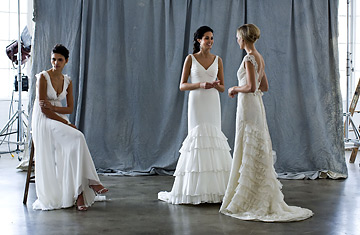
Models on a photo shoot for The Knot wait in a studio.
We met briefly at NYU's film school and reconnected years later at an alumni event. We were married six months after that, in 1993. We had sort of a whirlwind romance and planned our wedding quickly in a strange town where we knew no one. Several years later, when we were looking to get out of the work-for-hire world, a friend of ours brought up weddings. Lightning bolts went off in the room, and everyone thought, This is brilliant. Young people, the first to adopt the Internet, have a lot of money to spend in a short period of time and are desperate both for information and to communicate with lots of people at once. It was the perfect thing for a tired industry. The bridal world hadn't changed in 20 years. Friends wouldn't touch bridal magazines because they were full of icky poufy sleeves. So we thought we would use the Internet to fundamentally change the business of planning a wedding.
We partnered with two other NYU film grads. None of us were technologists. The epiphanous moment came when we were sitting around a computer and someone was demo-ing the Mosaic browser and said, "Look, we're now on a computer in Sweden." When you go through art school, all your friends become struggling artists, and the thing that restricts your ability to pursue your art or craft is distribution. The writer needs the publisher; the musician needs the label. All of a sudden there was this medium, and we could completely disintermediate the communication process. For us, that was like, Oh, my God, this is going to change everything.
Originally, we created a company called Element Studios to build media brands to profitability, with the plan to start a new brand every six months. Little did we know how difficult it would be. The first brand was supposed to be weddings; the next, home; and the next, a baby thing. We did a competitive analysis with Brides, Modern Bride, Elegant Bride and Bridal Guide. Online it was Weddingplanner.com, USAbride.com and WeddingsUSA.com. If you had the word wedding or bride in your title, you were what we called white noise. There were no media products in this category that people felt loyal to.
We wanted the Knot to deal with the stuff that traditional media companies wouldn't touch. They would never write about a Jewish girl bringing home a Jamaican boyfriend because they couldn't sell to ad agencies with an article like that. But the American wedding was changing. It was interfaith, intercultural, same-sex, plagued with family problems. Our brand said, Your best friends just planned a wedding, and they'll give you the inside scoop. It was an edgy attitude toward a category that had been staid for so long.
Our venture capitalists had a phrase that stuck with us, We are not investing in you to be No. 2. When you launch, you have to declare victory. Initial financing came from America Online. It needed content. People liked the fact that we were dealing with a life stage when there is so much need for information to inform purchase decisions. Hummer Winblad invested to empower the e-commerce component of the business, a wedding gift registry. When qvc invested, it was interested in helping us build our brand. We had only $1.7 million in the beginning, and then we reached $3 million. A year later, people were throwing $10 million and $20 million at people just for waking up in the morning. But that wasn't our culture.
If you want venture capital, being a husband-and-wife team is not looked very kindly upon. And we didn't know if it was something that would help us or hurt us. We also had two other business partners, so we wanted to be seen as equals. But it was funny — AOL gave us the money and never knew. People would ask, "Are you married?" and we would say yes but implying that it was to somebody who wasn't in the room. In the end, we considered it a competitive advantage because we were working from the moment we were brushing our teeth in the morning to the moment our heads hit the pillows at night.